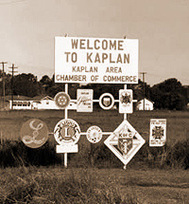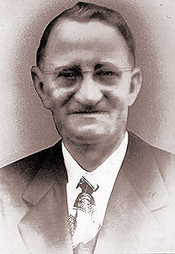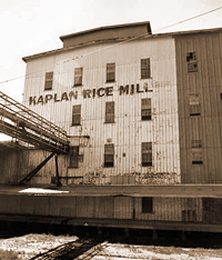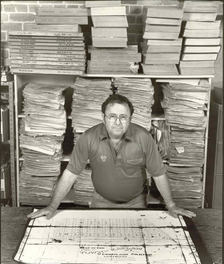The other day, a correspondent sent me a letter noting that the famous Indian actor, Iron Eyes Cody, whom you might remember from his litter and pollution advertisement in which he sheds a tear for the defiling of our beautiful country, was actually Italian, or, more precisely, Sicilian. He titled the letter עלמא דשיקרא, World of Lies, and linked to the relevant article on Wikipedia. Iron Eyes played the role so thoroughly, I think he ended up believing it himself.
I wrote back "At least he wasn't Jewish."
My correspondent replied "He was born in the city of Kaplan; that's close enough"
This remark reminded me of something I had recently seen, and I checked the ISP list of people who had recently accessed this blog, and I found that, amazingly enough, just yesterday someone had used a link at Shirat Devora to come to Havolim, and his ISP was The Kaplan Telephone Company, from Abbeville Louisiana, which is indeed where the town of Kaplan is located. This was an awesome coincidence, and too remarkable to let it pass. You can't be here for almost sixty years and never hear of a place, and then twice in one day have it emphatically placed right in front of you. This is not a 'hint.' This is more like being grabbed by the lapels and shaken. I'm sure that something is going on on a spiritual level, but I can't know what that is until it unfolds. But for right now, I wanted to know how on Earth a town in the bottom of Louisiana got the name Kaplan, so we went to work. This is what I found: Kaplan was founded by a man named Abrom Kaplan in 1902, as described in this Wiki article.
More interesting, and with a picture, is this history of the town and the family. Here's the link, but I wanted to put the whole thing here. For one thing, Abrom looks eerily similar to my uncle, my father's brother. And another, it makes you think about the strange and winding road we have walked since the beginning of the Diaspora- and even before that, as our father Abraham wandered from his home to Canaan. I direct your attention in particular to the fourth paragraph of the article.
What follows is copyrighted by the Goldring-Woldenberg Institute of Southern Jewish Life, reprinted with permission.
Encyclopedia of Southern Jewish Communities - Kaplan, Louisiana
Kaplan: Historical Overview

Considering its location among some of Louisiana’s oldest municipalities, Kaplan boasts a relatively short history. Situated 20 miles southwest of Lafayette and ten miles west of Abbeville, this small town lies at the epicenter of a lucrative rice industry that has transformed the region from swampland into an agricultural hub. Abrom Kaplan, a local Jew and agriculture tycoon, founded the town in 1903 after purchasing the land from a plantation that had recently closed. To attract an active workforce to the area for his rice mills, he gave away parcels of this fertile land to families. Abrom Kaplan also lobbied local railroad officials to extend the tracks from Gueydan to Kaplan and Abbeville, which contributed significantly to the town’s development. Amidst the town’s growth, a few Jews made their homes in Kaplan, including the Jack Kaplan and Tartak families, and became active members of Congregation Gates of Prayer in nearby New Iberia. Yet despite Abrom Kaplan’s important role in the regional Jewish community, most residents of the town over the past century have not been Jewish but rather French-speaking descendants of Acadians.
Stories of the Jewish Community in Kaplan

Abrom Kaplan
In the 20 years before the town’s incorporation, Abrom Kaplan had become a pioneer in Southwest Louisiana’s rice industry. He emigrated from Poland in 1885, after having spent his adolescence working in cigar and furniture businesses. After settling in Crowley, Kaplan opened a small store and speculated in real estate. He developed land, established local banks and credit unions, and financed the excavation of irrigation canals. Most significantly, Kaplan developed a crucial flood control method to keep salt water out and let bayou water in, allowing the rice crop to thrive across the region. Using this innovative irrigation system, Kaplan opened rice mills throughout Crowley, Abbeville, Gueydan, and several other towns west of the Mississippi River.
By the turn of the century, Kaplan was known as one of the region’s foremost industrialists, as well as southwest Louisiana’s largest tax-payer. As such, Kaplan began to represent the interests of rice farmers with prominent legislators both locally and nationally. In 1922, Kaplan went to Washington to attend a conference with Secretary of Agriculture Henry C. Wallace, and even dined with President Harding.
As Abrom Kaplan built his fortune, he began to bring his relatives to Southwest Louisiana. In 1915, Abrom paid for his nephew, Jack Kaplan, to immigrate to the United States from Poland. Jack worked under the tutelage of his uncle Abrom for two decades and by 1935, Jack and his brother-in-law Abe Tartak bought Liberty Rice Mill, one of Abrom’s many mills in the region. At the time of Abrom’s death in 1944, the Kaplan family owned the largest rice irrigation system in the world.
In the 20 years before the town’s incorporation, Abrom Kaplan had become a pioneer in Southwest Louisiana’s rice industry. He emigrated from Poland in 1885, after having spent his adolescence working in cigar and furniture businesses. After settling in Crowley, Kaplan opened a small store and speculated in real estate. He developed land, established local banks and credit unions, and financed the excavation of irrigation canals. Most significantly, Kaplan developed a crucial flood control method to keep salt water out and let bayou water in, allowing the rice crop to thrive across the region. Using this innovative irrigation system, Kaplan opened rice mills throughout Crowley, Abbeville, Gueydan, and several other towns west of the Mississippi River.
By the turn of the century, Kaplan was known as one of the region’s foremost industrialists, as well as southwest Louisiana’s largest tax-payer. As such, Kaplan began to represent the interests of rice farmers with prominent legislators both locally and nationally. In 1922, Kaplan went to Washington to attend a conference with Secretary of Agriculture Henry C. Wallace, and even dined with President Harding.
As Abrom Kaplan built his fortune, he began to bring his relatives to Southwest Louisiana. In 1915, Abrom paid for his nephew, Jack Kaplan, to immigrate to the United States from Poland. Jack worked under the tutelage of his uncle Abrom for two decades and by 1935, Jack and his brother-in-law Abe Tartak bought Liberty Rice Mill, one of Abrom’s many mills in the region. At the time of Abrom’s death in 1944, the Kaplan family owned the largest rice irrigation system in the world.

Jewish Life in Kaplan
Despite the lack of Jews in town, Abrom Kaplan still strived to remain connected to the Jewish community. While Kaplan itself never had a permanent synagogue or Jewish cemetery, Abrom served as an officer of the Jewish Cemetery Association in Lafayette, where he was later buried. When Kaplan died, moreover, religious services were held at the Crowley Mason Lodge, which was said to have functioned temporarily as a synagogue for the few Jews in town. Kaplan’s first wife, Rebecca Lichtenstein of New Orleans, was also active in the area's Jewish life as a member of both the Crowley Chapter of the Order of the Eastern Star and the Jewish Sisterhood of Congregation Gates of Prayer in New Iberia.
At the same time, Kaplan’s small Jewish population was well integrated in the larger community. Abrom Kaplan helped fund the creation of several churches in the town, including the Kaplan Baptist Church. His grandson and son-in-law also helped fund the town’s Holy Rosary Catholic Church in later years. At its peak, the town of Kaplan served as a major shipping hub, complete with a post office, Catholic Church, school, telegraph company, and town newspaper.
Despite the lack of Jews in town, Abrom Kaplan still strived to remain connected to the Jewish community. While Kaplan itself never had a permanent synagogue or Jewish cemetery, Abrom served as an officer of the Jewish Cemetery Association in Lafayette, where he was later buried. When Kaplan died, moreover, religious services were held at the Crowley Mason Lodge, which was said to have functioned temporarily as a synagogue for the few Jews in town. Kaplan’s first wife, Rebecca Lichtenstein of New Orleans, was also active in the area's Jewish life as a member of both the Crowley Chapter of the Order of the Eastern Star and the Jewish Sisterhood of Congregation Gates of Prayer in New Iberia.
At the same time, Kaplan’s small Jewish population was well integrated in the larger community. Abrom Kaplan helped fund the creation of several churches in the town, including the Kaplan Baptist Church. His grandson and son-in-law also helped fund the town’s Holy Rosary Catholic Church in later years. At its peak, the town of Kaplan served as a major shipping hub, complete with a post office, Catholic Church, school, telegraph company, and town newspaper.
The Jewish Community in Kaplan Today
 Connie Kaplan
Connie Kaplan
Today, Kaplan is known affectionately as the “gateway to the coastal wetlands” and occasionally as “the most Cajun place on earth.” Few if any Jews still live in the small town of 4,500 residents, many of whom still work for the rice industry. The town instead celebrates the French-Cajun heritage of its populace. Each July since 1906, Kaplan has hosted the largest public celebration in Louisiana of Bastille Day, the French national holiday celebrating the famed uprising on the eve of the 1789 French Revolution. Events at the festival include greased pig chases, political speeches, Cajun fais-do-do dances, and a re-enactment of the storming of the Bastille. The presence of the Kaplan family has abated significantly; however, the legacy of Abrom Kaplan lives on. One descendent of Abrom, Connie Kaplan, served as the editor of the local newspaper for several decades in the late 20th century. Several years ago, Jack Kaplan donated some of the family’s land to build the Abrom Kaplan Memorial Hospital of Kaplan, one of the most modern medical facilities in Southwest Louisiana. Kaplan’s Planters Rice Mill, too, continues to function today, a subtle reminder of the Jewish past of Kaplan.


9 comments:
Sam and Sally Kaplan were my Grand parents, and when I was six years old, Sam; would invite the other kids that were different races than I was, and told me to love all people, who the people they were. My father, Sam's father; always hated me, and had others hate me to this day. There is many things wrong in the Midwest, but when I had taken on line writing, and studied acting, I had discovered my creative traits were not from Sam or his wife, it was from Abrom Kaplan. I am working on a book, and would like to discover more people still living, that was born on Abroms's side. Gail Kaplan
How thrilling it is to get a message from you! I thought it amazing that Abrom, that lonely Jew, managed to put down roots in the most unlikely place, and now I see that his heritage is being carried on.
Thank you for writing.
I am the granddaughter of Jack Kaplan and the great niece of Abrom. I still go to Kaplan at least a few times a year. My kids are also well aware of this legacy. http://forward.com/culture/179473/abrom-kaplans-cajun-dream/
Thank you for your comment. The Jewish spark goes on! Be well. If you're ever in Chicago, look us up, we'd be happy to meet you.
Great article! I'm also from Kaplan. Would love to know more about Abrom Kaplan's descendants and where they are now. My family is a 3rd generation rice, soybean, and crawfish farmers just north of Kaplan around the Cossinade area. Cole Landry
Email: colelandry@hotmail.com
Thank you.
My wife and I love to go on long road trips, but the closest I've been to you has been a trip to a wedding in Charlotte NC. If I'm ever down around Cossinade, I'll look you up!
I knew Uncle Sam and Sidney and think we met when I came to visit them with Grandpa Jack as a kid!
My name is Gail Kaplan i would like to do more on the Kaplan History, my printer has to be fixed and one of my neighbors is going to help me fix it, and then go on Ancessory. com and find much more important facts on our Kaplan family tree. I just love what Such Possibilities for change had written today, she had met my Grandfather Sam, and Sally his wife's brother Uncle Sidney, I do remember meeting her Grandfather Jack; when I was a kid. I miss all those people so much there was so people in our family, quite as wonderful as those people were to me, I have Kaplan family dreams all the time, the closeness, unity, peace, and love, I had shared with the Kaplans, I ask and pray to the Lord, all the time, I would love to bring them all back to life, if I could. I never knew what had happened when she and I were kids, to many decades of years, why Sam Kaplan, and Jack Kaplan we never had other beautiful gatherings that we could see them much more than only when we were kids. This post must be my cousin Sara, I had met, when I was a kid and met her Grandfather Jack. I always loved Sara; she was so cute her southern accent, or maybe this another cousin that has the same memories, that we need to know much more, on our loving people; the Kaplans.
Post a Comment